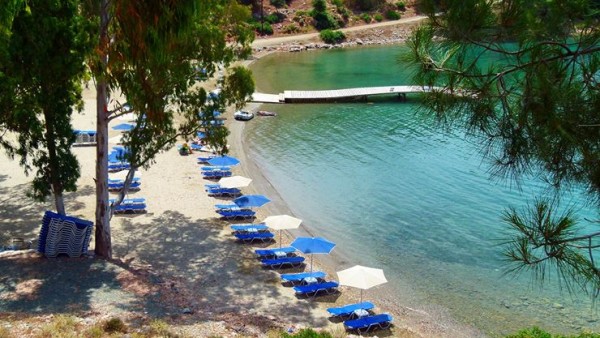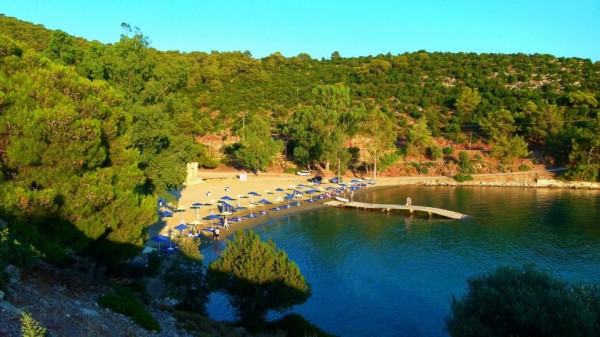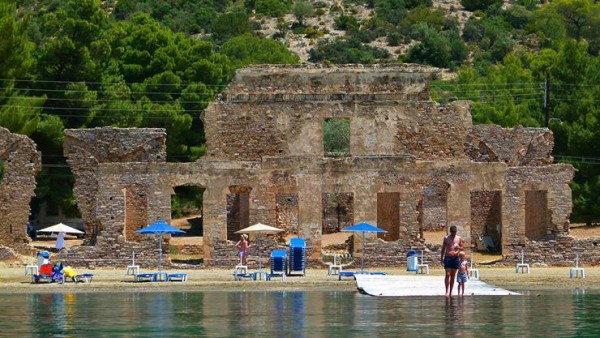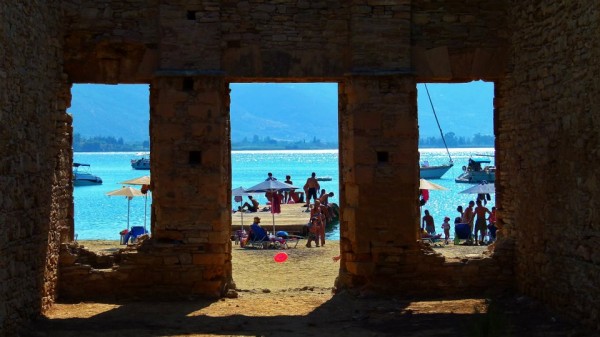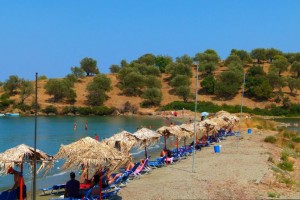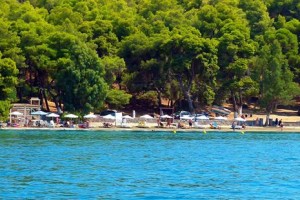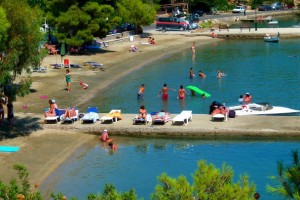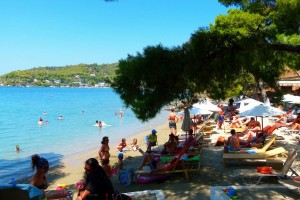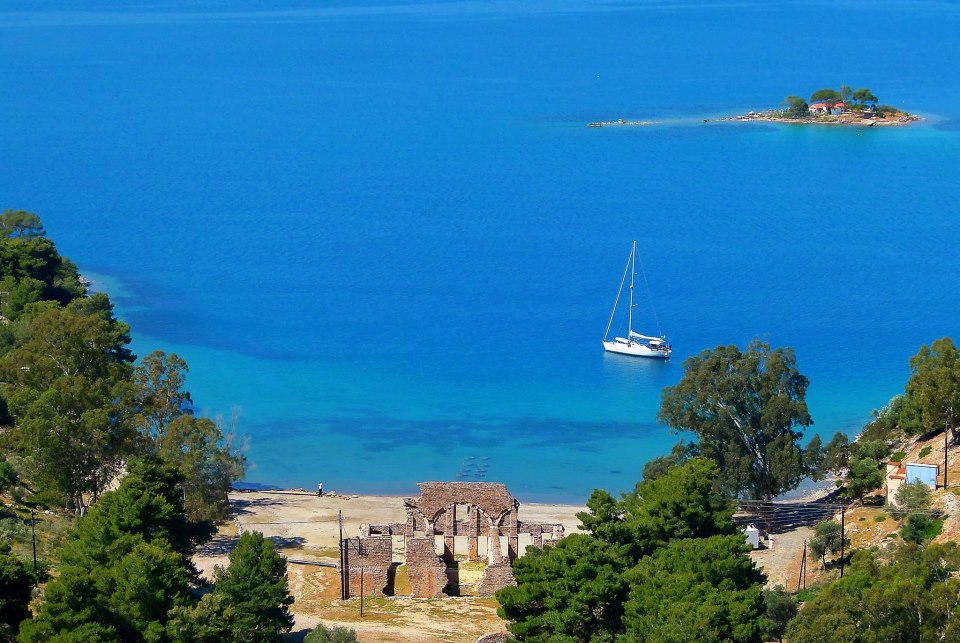
From a distance, the derelict facade at Russia Bay is sometimes mistaken for ancient ruins, but are in fact what remains of an early 19th-century base built for the Russian Navy.
The ruins add an exotic note to the bare surroundings—a beach of coarse sand and pebbles shaded by a few massive eucalyptus trees. The small sheltered bay, which includes an adjacent cove, offers good anchorage and is often crowded with sailboats and yachts on summer weekends. It’s handily located just inside the strait but partially concealed by a small islet, Daskalio, which sits opposite.
There are sunbeds and umbrellas for rent and a small refreshment stand that serves snacks.
Getting there: Russian Bay is about 4.5 kilometers from Poros Town and a relatively easy walk, with only a couple of moderate inclines. It’s also reached by road, either by private car, taxi, or the Neorio-Rossiko bus.
The Monument
On the April of 1770, a division of the Russian armada arrived in Greece commanded by Alexis Orlov, so that stimulating the slave Greeks in a rebellion against the Turks, who were in a belligerent condition with the Russians during that period. The Russian armada though was afflicted for months in the Aegean Sea in continual attacks against the Turkish armada, in which the Russians showed a big sloth and clumsiness. Eventually, the Russian armada made a sea battle with the Turkish armada on October of 1770 in Lemnos.
There, Orlov himself, in a panicked condition, took a frigate and left, giving the command to the armada to follow him in Italy. Then, the Greeks that were participating at his crews convinced him after many requests not to abandon the fight. So, he turned back again to the Greek coasts and established his admiralty in Poros.
From there, staying inactive for three years, he commanded 14 islands of the Aegean that he had under his possession. Orlov constructed the Russian storage rooms at the place where the K.E. POROS is today. Besides the storage rooms, he also constructed a bakery, cooking places and other buildings for the support of his armada.
The Greek State bought these buildings in 1834, when it founded there the first Naval Yard of the Greek state. Poros had become then “the naval yard of the Greek Nautical power, being naturally at this defined” and “the seed bed, in a manner of speaking, of the Greek sailors.”
At that time, besides the Greek ships, the French, the English and the Russian armada were steered at the leeward narrows of Poros. The Nautical Russian Service, after the sale of the old storage rooms to the Greek State, constructed new ones in 1834 at the area of Neorio, which is named Russian naval yard today at the breast of the cove, across the islet “Daskaleio”.
These buildings were used for the storage of materials and foods, production of the hard-tack (galeta), and storage of coal for the feed of the Russian armada that was found in the Mediterranean. This place was delivered to the Russian Government by the eldership of Poros of that time, as an evidence of the gratefulness for the offer of the Russian armada in the Greek situation.
The Russians preserved the property of the storage rooms and the bakeries of the Russian Naval Yard with the surveillance by a paid guardian until the year of 1900, when the ambassador of Greece in Petersburg, Al. Tompazis, knowing about their deserted condition, convinced the Russian Embassy to give their ownership to the Greek Government. The last guardian that was paid by the Russian embassy is referred to be Panagiotis Salonitis, and after his death, his wife.
The Greek Government delivered the area of the Russian Naval Yard with the old buildings to the individual N. Sxiza. Later on, many transfers had been made from an individual to an individual.
Eventually, in1989, according to a decision of the Ministry of Culture, these buildings of the Russian Naval Yard were characterized as historical and tenable monuments and a zone of security of 100 m. was defined round the outline of the buildings. Nowadays, the coast of the Russian Naval yard has clean sand and suitable sea for swimming, while in the sea area of the gulf many crafts are docking during the summer.
Architectonic elements of the Russian Naval Yard
Nowadays, the Russian Naval Yard is a complex of stone semi-derelict buildings. The main building, which prevails over the beach, consists of three narrow-front spaces placed in a row, which have a rectangular ground plan and are housed with the same number of big domes.
Their fore front towards the beach is almost two-floor and is divided into two zones, with a horizontal decorative tape made of smooth plaster.
The domes are hiding with a high breast wall, which is decorated with a horizontal marble tape with lineal vertical bars. The openings are placed axially and are repeated rhythmically; the same for each dome and have a lineal stone lintel with a decorative key. At the internal, the domes have been demolished and only their tracks on the walls are distinguished.
Behind the main building, there is a second complex of storage rooms that look at the main entrance, show the semi-circled drums at the main face. Their base is underlined with a entablature of slates.



